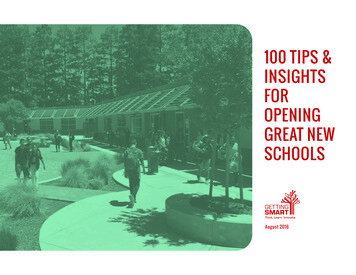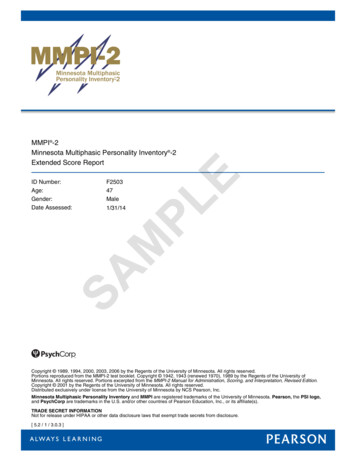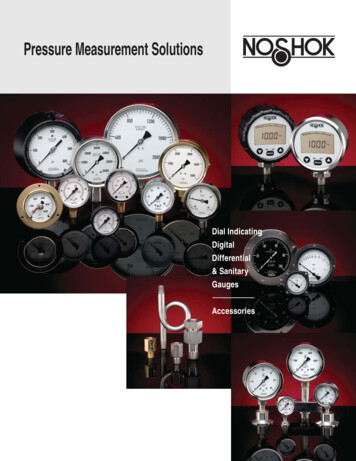
Transcription
100 TIPS &INSIGHTSFOROPENINGGREAT NEWSCHOOLSAugust 2016
TABLE OF CONTENTS0102Cover Image:Bulldog Tech, Silicon Valley, Calif.Good Schools Start with Good Design05Visit Great Schools06Job No. 1: Get the Culture Right09Create and Manage a Project Plan13Lessons in Leading New School Development20Resources21Acknowledgments22Appendix: Design TemplatesSTAY CONNECTED#NewSchools@Getting 07Make the Best of a Bad Situation07Create Culture On-Ramps08 Acknowledge Positive Culture as Precondition forGreat Teaching111112131414151617171818Plan and Market for EnrollmentPrepare for Day-to-Day OperationsSecure ResourcesBuild and Test AgreementsMarket Your DistinctivenessMake Learner Experience Vision a RealityHire Early, Hire WellStay Flexible, Distribute LeadershipBuild Reputation, Make FriendsSequence (But Don’t Forget) InnovationsListen to FeedbackSharpen the Saw
INTRODUCTIONTen thousand new schools opened in the last two decades – both a literally andphysically groundbreaking development in American education. New schoolshelped boost U.S. graduation rates and college enrollment rates during that time.About a quarter of these new schools were supported by charter managementorganizations and another quarter by nonprofit school developers working withschool districts. These organizations and their funders have learned plenty abouthow to open a great school.Opening a good, new school is a huge challenge. It is complicated under the bestof circumstances. It involves real estate, construction, financing, logistics andmarketing – many tasks outside the experience of even veteran educators.“Most of us want to start schools because we like instruction, but the one thingno one tells us is that when you start a school, 90 percent of what you do early onhas nothing to do with instruction,” says Dr. Nicole Assisi of Thrive Public Schoolswho has opened five Southern California schools.Given the complexity of opening a new school, the first piece of advice comesfrom Scott Benson, NewSchools Venture Fund, who suggests, “Start early. Giveyourself time to explore, design, seek feedback and build support among thecommunity and funders.”After starting as early as possible, most advisers say, getting the culture right isthe single most important factor in the long-term success of a school.New Schools ToolkitMost of this toolkit addresses the post-approval pre-opening checklist, butgiven this historic opportunity to create powerful new learning environments,the toolkit starts with important advice on school design (including two greatpodcasts). It concludes with a summary of 15 rules for great new schools andincludes a list of resources and contributors.Have more to add or questions to ask? Join the #NewSchools conversation.What’s most important when opening a new school? We asked two dozenexperts who have collectively opened more than a thousand schools. They shared100 hard-won lessons.OPENING GREAT NEW S CHOOL S GETT ING S MA RT01
GOOD SCHOOLS START WITH GOOD DESIGNMake sure that “instruction drives construction,” says Victoria Bergsagel,president of Architects of Achievement. She encourages new school teams toreflect their shared pedagogy and culture in their school facility.School (or district/network) leaders need to lead conversations that shape:}} Instructional design: instructional priorities, academic goals andteaching competencies (i.e., a vision for learner experience)}} School model design: schedule and physical space; staffing andperformance management; operations, finance and development; andblended learning models.The shift to digital learning and the emerging focus on competency-basedprogressions is making teaching more of a team sport with a higher degree ofcollaboration and with more flexible groupings across a mixture of learningstrategies. These new school models suggest new design principles:1. Lots of presentation spaces, some big, some small2. Quiet individual working spaces3. Places for teams to work and build stuff4. Inviting, natural light, connection to landscape5. Variety of fitness options for everyone6. Community connections/services7. Lots of broadband, lots of electrical outlets8. Energy efficient, sustainable9. Managed access and the ability to go from big facility to small facility10. Make everything flexible/convertibleVictoria Bergsagel, president of Architects of Achievement, helps teamsenvision successful and inspiring learning spaces. Read and listen for moreon designing beautiful learning places that encourage safety, belonging andcollaboration. Watch Victoria Bergsagel describe how we can couple whatwe know about learning with the development of productive learning spaces.“Develop a strong visual identity: By designing clear anddistintive physical learning environments, you can create agreat sense of belonging and source of inspiration for bothstudents and educators. It is also an opportunity to reflectpriorities and establish your culture.”—Kelley Tanner, Educational Facilities Planner with BrainSpaces anda Board Member with Association for Learning Environments (A4LE)OPENING GREAT NEW S CHOOL S GETT ING S MA RT02
Horace Mann Elementary in northwest Washington, D.C., is a greatexample of school facility developed in support of an instructional designand school model.The school values complementary approaches: one that offers studentsexplicit strategy-based instruction, and one that offers a broad,constructivist approach that allows students to linger in the exploratoryand discovery phases, only later to arrive at explicit ones. After a seriesof community conversations, Principal Liz Whisnant (left standing)converted the school’s academic program into facilities design principles(see Appendix).Liz Whisnant is principal at Horace MannElementary, a student-centered, personalizedlearning environment serving a diverse studentbody in northwest Washington, D.C., Readand listen for more on translating a vision forlearning into a new school design.Three examples of how instructional priorities were converted to designprinciples include:}} Collaboration and Connection: central common space forcommunity gatherings a library, science lab and art studio;purposeful gathering spaces for adult learning; and plenty ofwindows to make learning visible to all.}} Sustainability and Stewardship: LEED Gold Certification;multiple-use spaces that promote efficiency and connection;rooftop gardening, a teaching kitchen and horticultural therapy.}} Choice and Invention: flexible and public spaces for learning,mall-group and independent learning spaces (see picturedreading nook to the left), and spaces that invite inventive play!The entryway includes a garden wall with art that spells out valuesevident in every room of Horace Mann: adventure, discovery, inspirationand imagination.OPENING GREAT NEW S CHOOL S GETT ING S MA RT03
Want a Great School? Get the Board on BoardBy Carrie Irvin, Charter Board PartnersOne of the most foundational, and often overlooked, aspects of starting agood school is a good board--they can be the difference between a goodschool and an extraordinary school.HERE ARE SEVEN TIPS:1Focus from the very beginning on building a governing board,not a “friends and family” board. Think strategically about boardcomposition – make sure the board includes all relevant skill sets,including more than one person in key areas to give the board depth.Bring on people who can give you really sound and experiencedadvice – you couldn’t afford to pay people like that, but you can getthat kind of advice, guidance and support from your board. Don’tseek rubber stampers! You want tough questions and push backfrom a smart and engaged board – you will make better decisions.2Seek out good resources and training for your board – there isplenty out there so you don’t need to reinvent the wheel. And investtime in recruiting and onboarding your board members, even thoughyou’ll feel like you don’t have that time.3Invest in building formal, good governance processes and structures,and follow them. It’s not optional – good governance really mattersfor compliance, for engagement, for allowing different perspectivesto be heard and for keeping the board in the governance lane andout of micromanagement, while still allowing and encouraging boardmembers to make valuable concrete contributions.4Don’t limit the board’s role to fundraising and facilities. You needyour board by your side and to have your back, including duringthose tough early years. Think of it as a partnership – a great schoolneeds both a strong leader and a strong board to be great and tosustain greatness over time.5Make sure the board is involved and engaged and knows what’sgoing on. Proactively tell the board everything important that’shappening, especially what’s keeping you up at night. If you don’ttrust the board with sensitive or difficult information, you have thewrong board. The board chair should be your first call when youhave a problem or something goes awry, not the call you go to greatlengths to avoid making.6Boards must be aware of particularly sensitive issues involvedwith running a school and be informed and prepared to handlethese. In preparation for a school opening, the board, district orcharter should be familiar with state laws that protect individualsfrom discrimination, particularly students with disabilities, Englishlanguage learners, or students who come from economicallydisadvantaged families. Board members need to ensure that theirschools are adequately serving students within these categoriesand must be aware of laws governing their education. Boardmembers should ensure that their schools are in compliance withcivil rights laws and must be aware of the role they may play inaddressing disciplinary issues.7For charter boards, it’s important for boards to always knowwhat promises the school made in its charter, when the charter isup for renewal, what it will take to gain renewal and under whatcircumstances the school can be closed (at least 13 states havedefault closure laws).Bad things can happen when schools don’t have a good board. At best, theschool misses out on valuable leadership, guidance, resources and support. Atworst, boards jeopardize the success of the school, overlook or fail to preventmissteps and wrongdoing, or engage in illegal or unethical behaviors. Investin good governance from the beginning; don’t wait till you run into a problemand then try to remediate it. Good boards matter, and ultimately students willreap the benefits.OPENING GREAT NEW S CHOOL S GETT ING S MA RT04
Visit Great SchoolsThe most important aspect of the design phase is to visit great schools; you notonly see different designs but you experience the culture and context in a waythat the best video can’t convey. In the first minute of a visit, the sights, soundsand interactions give you a pretty good indication of the school culture. Visitschools with other people and build in some time for reflection. You will see aschool from several perspectives, and it will be a powerful professional learningexperience.“Visit other schools to learn the details of how others were doing things,”encourages Ben Daley, CAO at High Tech High. “At this point, there are many,many folks across the country with experience starting schools. Get out of yourbubble and talk with others who have done it.”“When it comes to schools, seeing is believing,” says Brian Greenberg, SiliconSchools. “I’ve found it more effective to take educators to schools where theycan see new models in person rather than trying to convince them with onlywords.”Visiting 100 schools in seven countries proved transformational for thefaculty of Singapore American School, says superintendent Chip Kimball.Their professional learning communities proved to be a critical vehicle for SASfaculty to discuss, synthesize and incorporate observed innovations. A cultureof excellence, possibility and care makes SAS an inspiring school worth visiting.After the design phase and having secured a building and funding: What’s next?The rest of this tool kit outlines the final countdown and opening days in thelife of a new school. The next section underscores the importance of gettingthe culture right.OPENING GREAT NEW S CHOOL S GETT ING S MA RT05
JOB NO. 1: GET THE CULTURE RIGHT“Attend to your culture,” says Jim May, who supports about 25 new schoolseach year for New Tech Network. “From certificates of occupancy toemergency plans to hiring, the list of operational realities that must beaddressed when starting a new school is immense. Thus, it can be easy tooverlook the importance of your staff and student culture during those earlydays. However, it is imperative that even amidst the swirl of starting the schoolthat you are intentional about establishing a strong set of cultural norms andrituals that can animate your work in the coming year.”Andy Calkins, whose Next Generation Learning Challenges has sponsored100 new schools through national and regional grant programs, says: “You willbe tempted to immerse yourself in the vast sea of logistical details startinga school entails, to the point of losing sight of the big picture: focusing onorienting your students/families and immediately establishing the culturebuilding that is so crucial to school and student success. Don’t lose sight of that.Everything else at the start is a detail.”“Pay attention to culture,” says Pat DeKlotz, Kettle Moraine School District,who has sponsored four charter schools that operate inside district schools(like KM Global, right). “Listen to students and take the time to nurture thehuman element. People want identity and purpose. Build that into the cultureof your school and you will go far. The processes are important only as long asthey bring people along.”New Tech High in Napa, Calif., got a lot right asa new school 20 years ago with big integratedprojects, 1:1 technology and a collaborative,inquiry-based culture. Read and listen tothe New Tech Network story about howthey added personalized learning and scaledthe model to 200 schools nationwide. Seeadvice from Jim May of New Tech Networkthroughout the rest of this toolkit.OPENING GREAT NEW S CHOOL S GETT ING S MA RT06
“If the students are engaged in the learning, they will communicate theirsuccess to the parents,” adds Pat DeKlotz. “A shared vision isn’t shared if it istold. It only becomes shared when people participate in making meaning ofit, together, co-creating the work. The “why” of what you are doing needs topermeate each individual involved, students, staff, partners.”Make the Best of a Bad SituationMore than slogans on the wall or values in a brochure, culture comes downto what you do and say. “Build the culture you want because if you don’t aculture will form and you might not like it,” says Diane Tavenner, SummitPublic Schools. “The thing about culture – values, beliefs, behavioral norms,traditions and rituals – is you ALWAYS have to make decisions and behave inalignment, even in the 90-day countdown.”“There is no version of launching a new school where something does not gowrong,” says Jim May. “When something goes wrong, think of it as a culturebuilding opportunity, a chance to “strengthen relationships and fosterresilience.”If you want a culture that values innovation you need to identify theprocess that your school will use to manage it. “The most innovative schoolssucceed because they consistently improve their 1.0 school models,” saysAlex Hernandez, Charter School Growth Fund. “It’s easy for innovation tostop once the kids show up because the team gets overwhelmed with thedemands of running a school, particularly when something goes wrong. Andit always will when you’re opening a new school.”Create Culture On-Ramps“Spend quality time onboarding ALL, not just new teachers – emphasizing a‘high expectations and whatever it takes’ culture,” says Terry Grier, formerHouston ISD superintendent. “Invest heavily in the orientation experience,”says Jim May. He notes that it is common for new school staffs to benefitfrom only a couple of hours of orientation before the first day of school.“This represents a monumental opportunity missed. There are very fewmoments over the course of a school year where you can frame yourmission, catalyze the collective energy of your team and set a direction forthe school as a whole.”“If your school is pursuing personalized, next generation learning, teachersneed to experience it fully themselves, as learners, before they can enabletheir students to embrace it,” says Andy Calkins. “Don’t think in terms ofhours of PD – think how can we develop, with teachers, a strong culture ofongoing professional learning?”“Think about how to help students acculture themselves to your learningenvironment,” says Alex Hernandez, who has supported more than 500 newschools. “Will there be a boot camp or other introductory experience? Howdo you want to set the tone around student voice, student agency and joy.”OPENING GREAT NEW S CHOOL S GETT ING S MA RT07
Acknowledge Positive Culture as Precondition forGreat Teaching“Great teaching and learning is built on afoundation of great culture, so start withculture as a critical path for your teachers,parents and students,” says Mike Feinberg(left), co-founder of KIPP, a nationalnetwork of 183 high performing schools.“Teaching and living the values shouldbe intentional, explicit and full of joy,”says Aaron Brenner of 1 World Networkof Schools, a nonprofit sharing lessonsfrom KIPP with communities worldwide.Brenner adds:}} Mission Orientation: Ensure everyone on the team is orientingtheir work around the successful execution of the mission beginningwith preparation and organization of the classrooms, planning ofan outline for the year, planning of detailed lesson plans for the firstmonth of school, visiting the homes of the children who will attendyour school. Every action in those last 90 days should be a reflectionof the belief in and commitment to that mission.}} We Watch What We Do To See What We Believe: Beliefs (why)with values as actions (what) with operating norms (how) withartifacts (daily reminders) with the development of character(where). In recruitment of teachers, in personal development ofteachers, in training of teachers, there should be an emphasis inthe alignment of the school culture. Everything should align andeverything should help lead to the achievement of shared beliefs.}} Teaching and Living the Values Should be Intentional, Explicitand Full of Joy: Building on the cultural alignment above, leadershipand teachers should plan lessons that teach the values in an explicit,intentional and joyful way. Lesson Planning of Values Lessonsshould have criteria of success: Rich literature; Integration of LocalCommunity; Integration of Heroes; Opportunity to be Creativethrough writing, singing, dancing, performing, drawing, painting and/or beyond; a song that connects to the value; specific behaviors/operating norms that the students practice as a reflection ofstrengthening their living of the values.}} Artifacts Should Celebrate the Mission, Vision and Values of theSchool: Whether it is classroom doors decorated with a collegepennant that are also painted to match the color of the university,the value books blown up to banner size, quotes that align withthe values on every door and when you enter the building, symbolsof the values throughout the school, and uniforms that celebrateand support the mission and values. This intentionality makes theclassrooms, other learning spaces, entrances, play areas and everypart of the school come alive.Aaron Brenner suggests getting away from everything in the middle of the90-day countdown. “It will give you the space to breathe again, to reflecton what is needed to do in the final 40 days before launch, and the renewedstrength to do it.”Alex Hernandez says, “Culture eats strategy for breakfast.”OPENING GREAT NEW S CHOOL S GETT ING S MA RT08
CREATE AND MANAGE A PROJECT PLANIf you have gained approval, found funding, secured a location and are in finalcountdown, it is time to build your final pre-opening checklist.“Have a countdown,” says Diane Tavenner. “Know your goals, objectives andthe folks responsible for each. Check in regularly and make sure you are ontarget. Course correct if needed. Ruthlessly prioritize.”“Create a project plan with key deliverables, roles and responsibilities anddue dates. Have someone manage the project plan,” says Peter Piccolo(pictured left visiting Roots Elementary, an innovative new blended learningmodel). Peter Piccolo leads strategy from Denver Public Schools, which hasopened more than 100 schools in the last decade. He recommends meetingwith the core team at least once a week to review the project plan to ensureall key work is on track.“Despite all the planning, something will go wrong day one, week one,” PeterPiccolo warns. “Plan for it, learn from it and plan for how you will respondif a train falls off the tracks.” He recommends districts have an escalationprocedure.OPENING GREAT NEW S CHOOL S GETT ING S MA RT09
Aspire Public Schools serves 15,000 California and Tennessee students in38 schools. The Aspire team learned many lessons about opening great newschools over the years. CEO Carolyn Hack and Casey Hoffman, who supportsnew school development, urge new school teams to over-communicate.They note the hundreds of moving pieces and many stakeholders involvedtranslate to a high need for communication on every level.Aspire’s new school process includes:}} Process-alignment kickoff meeting with primary internalstakeholders from each team involved, including school leadershipand department representatives.}} Weekly check-in phone calls with primary internal stakeholdersfrom each team involved, including school leadership.}} A weekly update email to all internal stakeholders (including SeniorLeadership Team) with key headlines and action items.}} One central point of coordination to keep everything movingforward and to constantly check in with all key stakeholders.}} Debrief meetings to review highlights of process and lessonslearned once the school is up and running – the team learnssomething new every time.}} Weekly construction meetings: check-ins with facilities team/contractors and alignment sessions with facilities leaders andother team leaders impacted by the new site build: Operations, IT,Nutrition, Health and Safety, etc.}} Nutrition/lunch program: How does this fit into master scheduling?Double-checking all health code/permit requirements for the kitchen/food serving area and ensuring the proper equipment is ordered andinstalled.}} Furniture: Alignment on furniture needs should begin five to sixmonths before school openings as the process always takes longerthan anticipated. Getting quotes and designs from multiple furniturevendors can be time-consuming, but could save you money in the longrun. Schedule delivery of furniture as early as the site will allow tobuild in time for replacement furniture and a second furniture order ifnecessary.}} Drop-off/pickup routine: More often than not, the drop-off/pickuproutine is a headache for parents and staff from day one, especially ifthere is not a solid operational plan in place and all staff on board toexecute this plan. Visit other school sites with similar configurationsbefore their school year ends to learn from their process and bestpractices. Purchase extra cones, traffic vests, etc. and consider thepresence of crossing guards in the first few weeks at least.The academic program should guide the work, but don’t forget aboutoperational priorities. In the months leading up to a new school opening, theprimary focus should be on ensuring everything is ready for the academicprogram to flourish from day one.The Aspire team notes key operational priorities that cannot be neglectedand that need to be discussed as early in the process as possible:OPENING GREAT NEW S CHOOL S GETT ING S MA RT10
Mike Feinberg emphasizes the importance of execution. “Remember thatcountless seen and unseen details are the difference between mediocreand magnificent. The biggest difference between those schools (and otherorganizations) that succeed and those that fail is the ability to execute onthe plan written down on paper, making course corrections as necessary, butalways executing.”When it comes to adopting software systems, try to avoid a lot ofcustomization. “Unless you have internal expertise and deep pockets, do notplan to build custom software to support your school model in the first fewyears of operation,” says Scott Benson.“Under commit and over deliver. Managing expectations of students, familiesand faculty is critical as you open a new school that will take years to fully form.Communicate the vision frequently as well as the reality of what it will taketo get there,” says Kelly Wilson, High Tech High Graduate School of Education(see white paper).Despite an innovative design, Danny Medved found that it took sustainedoutreach efforts to Denver elementary schools to build enrollment in a marketwith a growing number of quality options.“Invest in your students and families so they all show up the first day excitedand ready to go,” adds Alex Hernandez. “Hard to focus on innovation ifenrollment is below expectations.”“Ensure everyone on the team is orienting their work around the successfulexecution of the mission beginning with preparation and organization of theclassrooms, planning of an outline for the year, planning of detailed lessonplans for the first month of school, visiting the homes of the children who willattend your school (if that is a component of school start-up, which I highlyrecommend),” says Aaron Brenner.“Every action in those last 90 days should be a reflection of the belief in andcommitment to that mission,” added Brenner.Plan and Market for EnrollmentPrepare for Day-to-Day Operations“Enrollment matters. No kids, no money for kids,” says Matthew Wunder, CEOof Da Vinci Schools, four innovative schools near LAX. “Keep your enrolledstudents connected and engaged with the school. Recruitment and retention isthe financial lifeblood of your start-up.”Seek support on the basics of starting a school; organizations like charterassociations and operations/finance support organizations have a long historyof advising on school start-up,” Scott Benson says.“Put in the extra effort to have the right number students in your program,”says Danny Medved, founder of Denver School of Innovation & SustainableDesign. “This takes time away from design, but without a critical mass ofstudents you are not able actualize the school design.”Nicole Assisi recommends having everything you need to operate on DayOne: attendance plan, safety plan, nutrition plan/provider and proceduresfor everything (e.g., coming on campus, checking in late kids, cafeteria use/behavior, dismissal, traffic control, technology use, classroom management).OPENING GREAT NEW S CHOOL S GETT ING S MA RT11
Matthew Wunder stresses the need to plan for service quality for internal andexternal stakeholders. He adds, “People like clear procedures but they don’tcare what you know until they know you care.”“Stress test as many of your key process and systems before students arrive,”recommends Peter Piccolo. “For example, if there is a full school welcomemeeting on the first day of school, do a dry run, ideally with young people soyou can receive feedback first hand from your stakeholders.”Secure ResourcesIf you’re opening a charter school, “Apply for your 501c3 as early as possible.You cannot do any fundraising until you have this,” says Nicole Assisi. “Mostpeople forget about this little step and have huge consequences of not beingable to bring in money. Nonprofit status for schools takes longer than otherorganizations, so start now.”“Secure critical resources to ensure that you can work the plan, reach yearone goals and initially bring the vision to life,” says Danny Medved, principal atDenver School of Innovation & Sustainable Development (right), a new schoolincubated by DPS Imaginarium and supported by a Carnegie grant.“Know the element that sets your school apart (STEM/ Maker,Entrepreneurship/ PBL, etc.) and secure and prioritize resources that will allowthis to shine for an early year one win.”The principal of an innovative district school says that, despite senior leadercommitment, working with middle managers to gain access to resources wasa challenge. “Many of them will do the same thing they have always done,or what they do for other schools, but I think every school should be a littledifferent.” He spent more time than planned dealing with bureaucracy andgetting ready to open a new school.For charter schools, Nicole Assisi says: “Don’t take operations into yourown hands when it comes to finance and school operations. It can be verycomplicating and counterintuitive. Just because someone has businessexperience, that doesn’t mean they understand how school finances work.For example, we used to have an accountant on our board who adamantlydisagreed how the state of California is handling finances, but just becauseit is bad business, doesn’t mean we can change the state. Team up withsomeone like ExED or EdTec or another vendor who ‘knows the business ofschool business’ and its quirks.”“A good lawyer is worth their weight in gold,” she adds. “Think of a charterpetition as a gigantic legal contract. You will want someone to look it over.”OPENING GREAT NEW S CHOOL S GETT ING S MA RT12
LESSONS IN LEADING NEW SCHOOL DEVELOPMENTLaunching your own school offers up many lessons. As discussed earlierin this toolkit, a significant theme within almost every interview with thesuperintendents and network CEOs was their agreement that getting theculture right was key to success. In addition to culture, the experts shareleadership lessons for successful new school dev
OPENING GREAT NEW SCHOOLS GETTING SMART 03 Horace Mann Elementary in northwest Washington, D.C., is a great example of school facility developed in support of an instructional design and school model. The school values complementary approaches: one that offers students explicit










